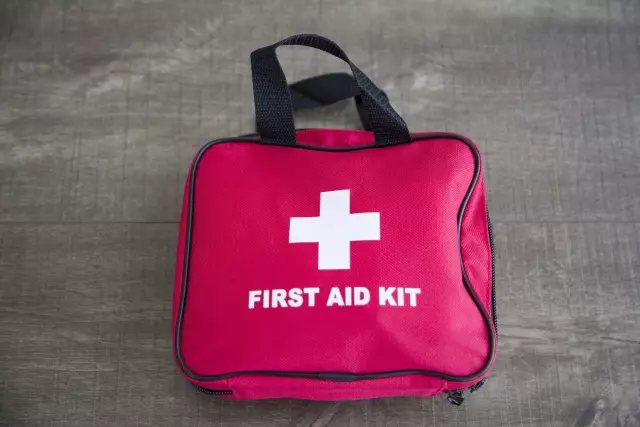- Author Curtis Blomfield [email protected].
- Public 2023-12-16 20:44.
- Last modified 2025-01-23 17:01.
Frostbite is severe tissue damage caused by exposure to cold. It cannot be ignored, otherwise you may face consequences that will not be easy to eliminate.
A brief description of the phenomenon
As a rule, it affects the protruding parts of the body - the head, insufficiently insulated arms and legs. Often it is also accompanied by general hypothermia.
It is enough to be in the cold at a temperature of -10 ° C to expose yourself to this. And since such indicators are not uncommon in our country, it is useful for everyone to know what to do with frostbite, which will be discussed now. Different situations happen, it can come in handy.
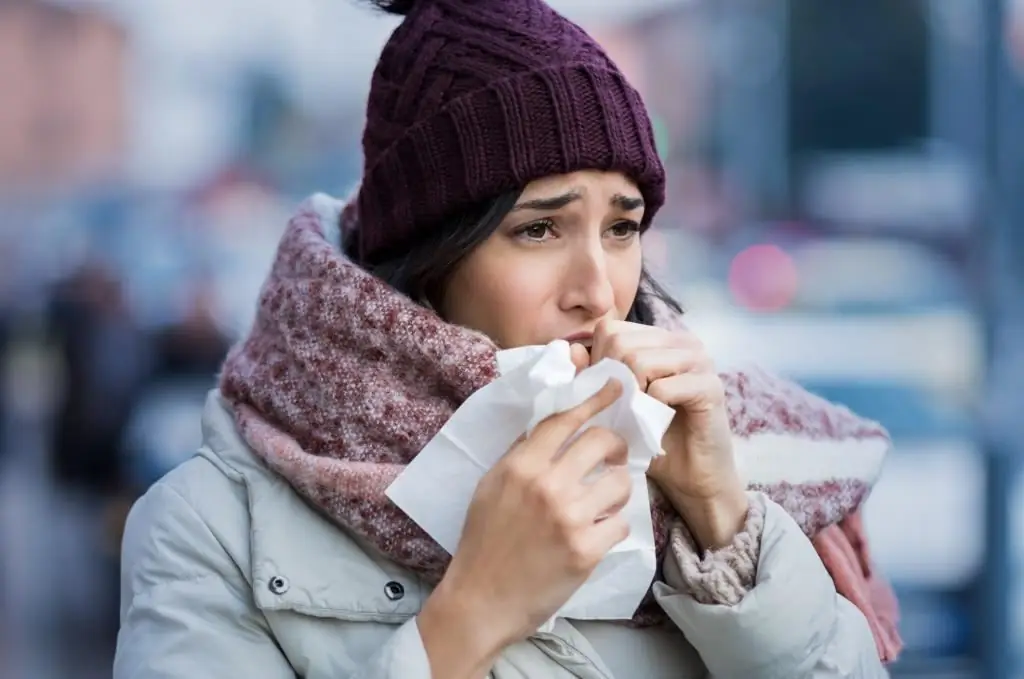
Symptoms and grades
To begin with, it is worth listing the signs indicating that a person has received frostbite. Here's how to describe them:
- 1 degree. Sensation of tingling, numbness and burning on the affected skin. The cover itself is pale. After warming, swelling and redness of a purple-red hue are formed. Passes in a week, accompanied by peeling.
- 2 degree. On the integument bubbles are formed, filled with a clear liquid. After warming, severe itching and sharp pain appear. The skin will recover for two weeks.
- 3 degree. All layers of the skin are affected. Obvious necrosis - necrosis, tissue death. There are bubbles, but they are filled with bloody fluid. Heals for at least a month, scars form.
- 4 degree. With it, all layers of the skin are affected by necrosis. There is persistent swelling and loss of sensation.
The first two degrees are more common. Because to get the third and fourth degree, you need to spend more than one hour in extremely low temperatures.
It should also be noted that frostbite is accompanied by hypothermia (body temperature can drop below 34°C), chills, decreased breathing rate, heart rate and pressure.
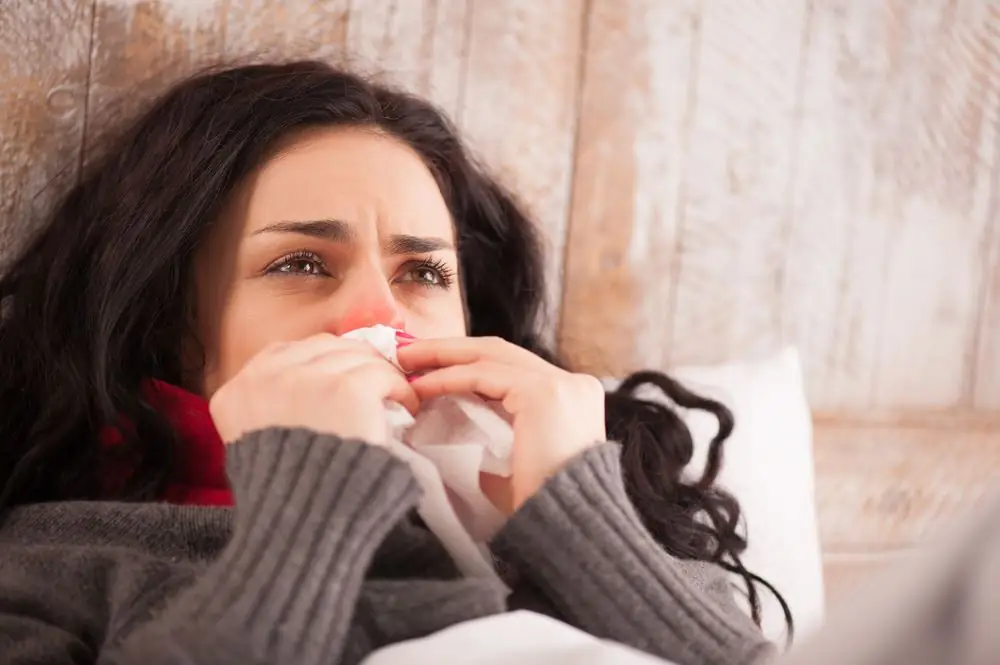
Primary actions
And now we can talk about what to do with frostbite. Naturally, the first thing you need to immediately go home if hypothermia is suspected, in heat. Along the way, you need to do the following:
- Put on a hat or hood if your ears are cold.
- Raise the collar of your jacket or sweater to hide your nose. Or tie your face with a scarf. If neither is available, it is allowed to cover the nose with gloved hands.
- In case of frostbite on the cheeks, do the same as in the previous paragraph.
- When hypothermia hands, you can put them in the armpits.
- If your feet are cold, then you need to be as active as possiblewiggle your fingers.
Is it far from home or destination? Then you need to find any room nearby - a store, a shopping center, a cafe, even an entrance will do. But the cafe is better. You can take tea or coffee to warm up.
But the most important thing is to move actively. This will increase blood circulation and minimize the extent of damage as possible.

Hands
Now in more detail about what to do with frostbite on a specific part of the body. First, about the hands.
You need to take off cold clothes, change into warm clothes. Make a hot (but not alcoholic) drink. Tea with lemon and honey, for example. And start warming your hands.
The process is phased. Do not immediately put your hands under hot water. You can start at around 20°C. As sensation returns and the condition of the limbs improves, slowly increase the temperature.
But it happens that at the most unnecessary moment the water is turned off. What to do with frostbite of hands in this case? You can rub them with a soft cloth, try to warm them with warm breath, and then wrap them with something warm (plaid, blanket).
After these actions, it should become easier. If instead of normalizing the condition, progressive swelling, blisters and acute pain appear, you should urgently go to the hospital.
Legs
So, here's what to do for frostbite toes and toes:
- When you get home, take off your shoes and socks.
- Fill temp. into a bowl of water. 20 °C, put your feet in there.
- Add boiling water as it warms up.
- Parallelrub the affected limbs with your hands, do a massage.
- Blot with a towel, put on a warm bandage or put on socks, you can preheat them on the radiator.
These steps will help. Physical impact will tone the feet, heat will restore blood circulation, socks or a bandage will protect damaged areas from infection.
If all else fails, call an ambulance. Until the doctors arrive, do not remove the warm bandage, cover yourself with a woolen blanket, and keep warm. Limbs must be motionless.
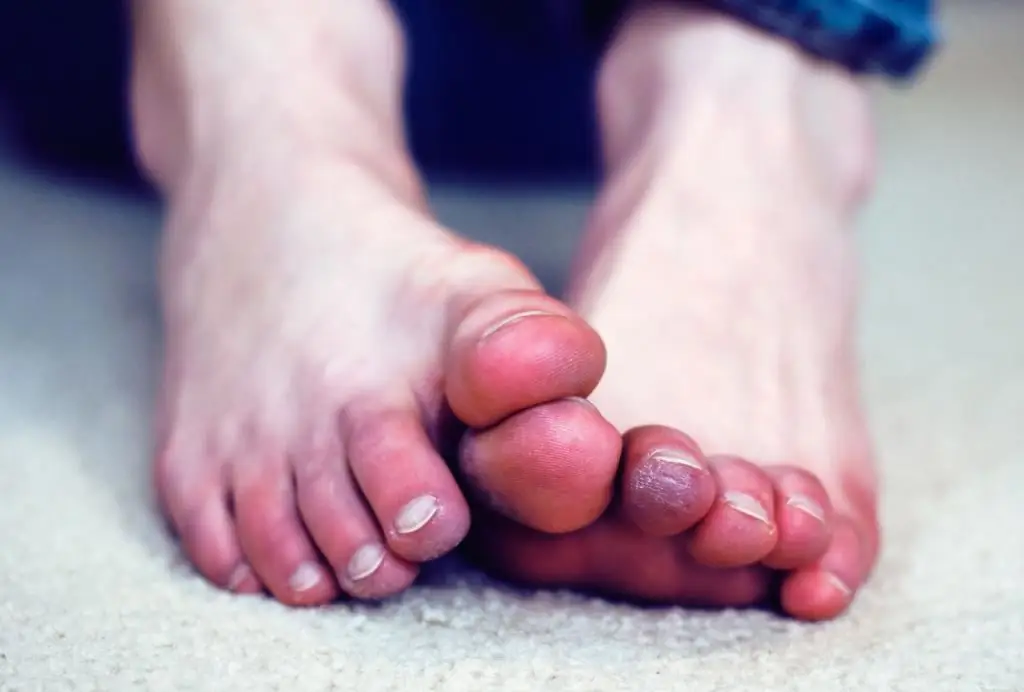
Face
The least protected part of the body in cold weather. Of course, one cannot help but talk about what to do with frostbite on the cheeks.
Actions are similar to the recommendations described above. First you need to get to a dry and warm room, change clothes. And then proceed to a smooth process of warming, trying to stretch it over time. Actions are as follows:
- First, you need to do a light warming massage.
- Then apply a heating pad to your cheeks and nose. Its external temperature must not exceed 30 °C. You can spend half an hour applying a heating pad.
- If the state has become normal, which is manifested in the preservation of basic reflexes and consciousness, then you can start drinking or eating something warm. But it should not be hotter than 35°C.
- After that, you need to go to bed under a warm and thick blanket, pulling it over your eyes.
By the way, if there is no heating pad, you can resort to an alternative option. Take warm water in a saucepan andcovered with a thick towel, hang over it. Sort of like inhalation. But! Steam should not be hot, but warm. And no essential oils or other additives need to be poured in there. A pot of water is only to create comfortable conditions for heating.
That's all there is to it. Frostbite on the cheeks of a child and an adult will pass after these activities, unless, of course, this is a case of an early stage.
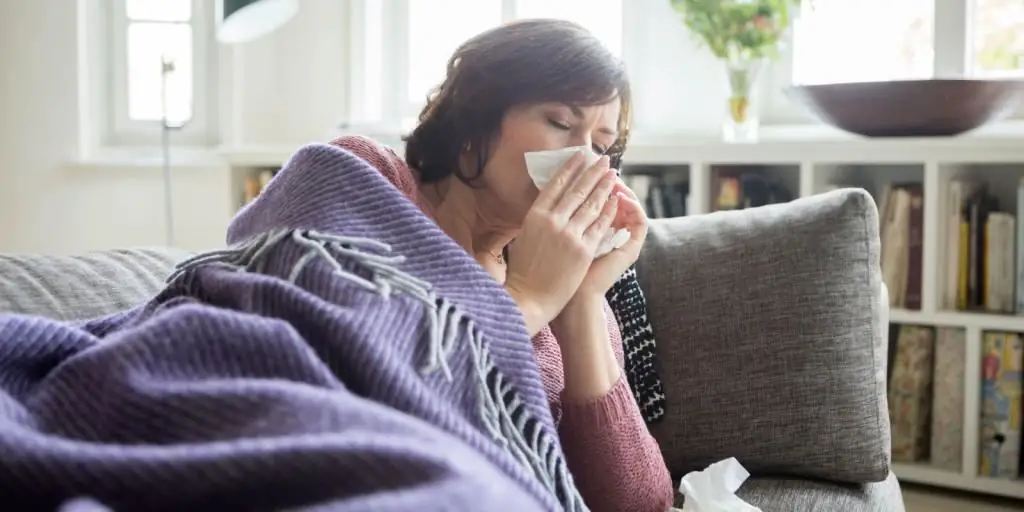
Prohibited activities
They also need to be listed. What to do with frostbite on the legs, arms, cheeks and nose is clear, but what actions can harm? So the list is:
- Rubbing with snow. That it will help is a lie. Such actions can only further cool the damaged area. Skin microtraumas and vascular spasms are guaranteed. For the same reasons, rubbing with essential oils and alcohol is prohibited.
- Drinking alcohol. Hot drinks give only the illusion of warmth, its subjective sensation. At such moments, everyone forgets that alcohol dilates blood vessels, which only worsens the patient's condition.
- Active rubbing of the nose. This part of the face is extremely sensitive. Rubbing can damage blood vessels, provoke bleeding, bacterial infection, trauma.
- Quick hot warming. Seductive, but not desirable. Due to the rapid entry of cold blood into the main circulation, which is immediately replaced by hot blood, blood pressure will drop sharply. So no fireplaces, hot water heaters, bathtubs or open flames.
And of courseSeparately, it should be said about self-treatment. Here's what not to do with frostbite for sure. Self first aid is acceptable, but aftercare should be performed by a highly qualified physician.
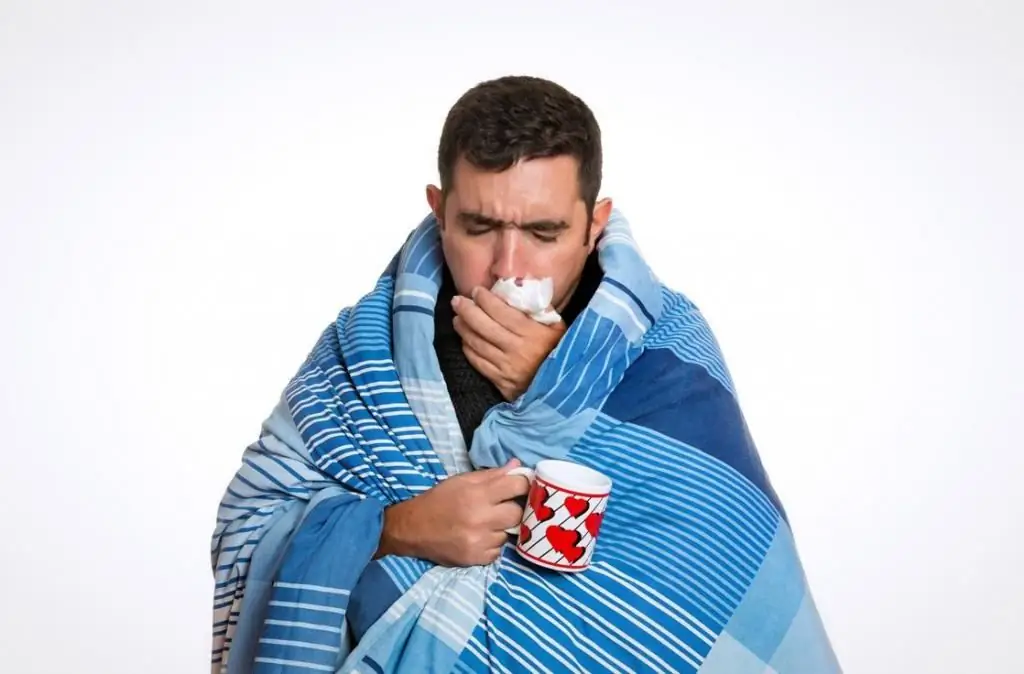
Consequences
It's impossible not to mention them. It is extremely important to take the problem of frostbite seriously, because what happened can lead to:
- The formation of granulations and scars on the skin that will remain forever.
- Massive necrosis, the appearance of gangrenous foci. In severe stages, amputation may be necessary to avoid infection.
- Secondary bacterial infections. They can be caused by cuts, abrasions and destruction of peripheral vessels.
- Failure of the kidneys and liver. This is a consequence of pathological processes.
- Blood sepsis, if the breakdown product of necrotic tissue enters the arterial circulation.
It would be possible to add a fatal outcome to the list, but this is a consequence of an extremely severe degree of frostbite and the absence of any medical assistance.
Treatment
It is prescribed by the doctor after the examination, he also indicates the duration of therapy and the dosage of drugs. Usually written:
- Anspasmodics. These funds effectively relieve spasms of blood vessels that interfere with normal blood circulation. The most common medicines are Mebeverin and Drotaverin.
- External remedies. They are needed for disinfection, weakening the inflammatory process, and also to get rid of necrotic tissues. Oftenuse Iruksol and Triderm.
- Analgesics. Eliminate pain syndrome. Most fit "Fentanyl", "Promedol" and analgin.
- Anti-inflammatory drugs. Both NSAIDs and hormonal steroid drugs are prescribed. The first includes "Ibuprofen", aspirin. To the second - "Dexamethasone", "Prednisolone", "Cortisol".
- Anticoagulants. Helps reduce blood clotting. May prescribe Warfarin, Dicoumarin and Heparin.
- Antiaggregants. They create an obstacle to thrombosis, inhibiting the adhesion of platelets. Great help "Triflusal" and "Kurantil".
- Vasodilators. The most popular are Papaverine, Theobromine and Chlorazicin.
In addition to the above, other drugs may be prescribed, starting with angioprotectors and ending with antibiotics. However, what to do with frostbite, and what medicines to take, the doctor will tell.

Folk remedies
They are recommended to be used only after the technique has been agreed with the doctor, and only for mild forms of frostbite. Here are some recipes:
- Compress. Mix a teaspoon of calendula tincture with warm water (0.5 l). Moisten a soft, small towel in the resulting solution and apply it to frostbitten places 2-3 times a day for 40 minutes. Treatment lasts 7 days.
- Natural mix. Mix 50 milliliters of celandine juice and lemon. Throw in some ginger. To stir thoroughly. Rub the resulting mixture on the affected skin three times a day for a week.
- Gadgets. tablespoonDried chamomile flowers brew a glass of boiling water. Wrap, let it brew for 2 hours. Strain and make lotion four times a day.
- Kalina. This berry is an old Russian remedy for frostbite. A few tablespoons of fresh viburnum should be poured with boiling water (0.5 l) and let it brew for 15 minutes. Strain. This volume is drunk in three doses - in the morning, afternoon and evening. It is recommended to make such a drink for 10 days.
Many cold sufferers say: if you get frostbite, do one of the following. After all, the means are effective and time-tested.




